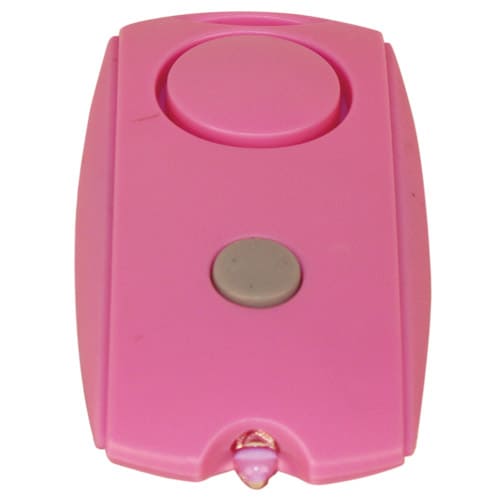What are the pros and cons of carrying personal alarms? Well, they can be a real lifesaver, emitting loud sounds to scare off attackers and alert bystanders. Pros include affordability, simplicity, and portability, making them easily accessible when you need them most. However, their effectiveness hinges on bystander presence and their reaction; also, the alarming noise isn’t foolproof in chaotic or loud environments. While they don’t replace thorough safety strategies, they’re an effective layer of protection. Dive deeper to explore if a personal alarm matches your safety needs.
Key Takeaways
- Personal alarms are highly portable and can be easily activated to deter potential attackers.
- They emit a loud sound, drawing attention and increasing the likelihood of bystander intervention.
- False alarms may lead to bystander desensitization, reducing the effectiveness of the device over time.
- In loud environments, the alarm’s sound may be drowned out, limiting its deterrence capability.
- Reliance solely on personal alarms can create a false sense of security, as they do not physically stop an attacker.
Understanding Personal Alarms: What They Are and How They Work

Personal alarms are compact and powerful tools designed to enhance your safety in threatening situations.
These small, portable devices emit a loud sound, usually between 120 to 140 decibels, effectively designed to deter attackers and alert people nearby.
Their various forms—keychain attachments, wearable gadgets, or stationary buttons—incorporate easy activation methods like pull pins or buttons.
The features that make personal alarms particularly appealing include advanced functionalities such as GPS tracking and fall detection, which are especially useful for seniors.
Depending on your needs, these alarms operate on different battery types, including disposable and rechargeable options, with some offering military-grade durability for reliable, extended use in any environment.
Pictured above is the The Mini Personal Alarm Flashlight Keychain currently on sale for less than $10 at Nittany Self Defense. Along with other personal alarms on sale for less than $15.
Key Benefits of Using Personal Alarms for Safety
When you carry a personal alarm, you’re arming yourself with a powerful deterrent that can emit a sound as loud as a jet engine, effectively scaring off potential attackers and drawing attention when you need help.
These devices are incredibly portable, easily clipping onto your keychain or bag, so you’re never without protection.
Plus, their simple activation, like pressing a button or pulling a pin, means you can react swiftly and confidently in threatening situations.
Deterrent to Potential Threats
Considering the risks in today’s world, having a personal alarm offers a significant advantage by acting as a potent deterrent against potential threats.
When you’re confronted with danger, you can simply press a button or pull a pin to release a loud noise that reaches up to 130 decibels—akin to standing next to a jet engine.
This startling sound not only scares off potential attackers but also draws the attention of those nearby, increasing your chances of getting help.
The simple act of activating your personal alarm can give you an essential moment to escape or gather your bearings, making it an invaluable tool in maintaining your personal safety and confidence.
Portable Safety Device
Beyond merely scaring off attackers, personal alarms serve as a versatile tool for your safety arsenal. These compact devices easily attach to your keychain or slip into a bag, ensuring they’re handy whenever you need them.
They emit a loud sound, up to 130 decibels—like standing next to a jet engine—effectively deterring potential threats and drawing attention in emergencies.
The pros of personal alarms are clear: they enhance your personal safety while being cost-effective and accessible, starting as low as $2.50. The cons, however, are minimal in comparison to the peace of mind and protection they offer.
With added features like GPS tracking and flashlights, personal alarms are indispensable for anyone prioritizing safety.
Simple Activation Process
One of the standout features of personal alarms is their simple activation process, designed to guarantee quick and easy use in any situation. You just need to press the button or pull a pin, and you’re seconds away from signaling for immediate help.
This ease of activation means you don’t have to fumble through complex instructions when you’re feeling threatened; it’s instinctive, ensuring you can act fast. Many alarms also include automatic features that further simplify the process, activating themselves under certain conditions to provide an extra safety layer without your intervention.
This straightforward approach not only enhances the effectiveness of personal alarms but also encourages their consistent use, making you more likely to carry and utilize them whenever you feel unsafe.
Here’s a short video about different types of personal alarms.
Common Situations Where Personal Alarms Offer Protection
If you’ve ever felt uneasy walking through a deserted parking lot or hiking a secluded trail, a personal alarm could be your best companion.
These handy devices act as a powerful self-defense tool. In poorly lit parking lots, activating a personal alarm can scare off potential attackers and signal for help, making you feel safer.
During outdoor activities, whether you’re tackling a remote path or setting up camp, a personal alarm serves as a vital alert system to draw attention during accidents or unexpected wildlife encounters.
For children, these alarms are particularly valuable, providing a quick way to alert others in dangerous situations.
Even in crowded places, using a personal alarm can effectively disrupt an assailant and buy you essential escape time.
Limitations and Challenges of Relying on Personal Alarms
While personal alarms can be a useful safety tool, you must be aware of their limitations, such as false alarm risks that can lead to bystander desensitization.
The variability in bystander response is also an important factor; not everyone around you may notice or choose to act when your alarm sounds.
This makes it essential not to rely solely on these devices but to take them into account as part of a broader personal safety strategy.
False Alarm Risks
Although personal alarms are a popular safety tool, their effectiveness can be compromised by the risk of false alarms.
Here’s what you need to know about these risks:
- Accidental Activation: You might unintentionally trigger your alarm, causing panic and chaos in crowded areas.
- Desensitization: Frequent false alarms can make people less responsive over time, assuming it’s just another false alert.
- False Sense of Security: Personal alarms rely on noise to deter attackers, but they don’t prevent an attack. You might feel safe, yet remain at risk.
- Unheard Alarms: In loud environments, your alarm might go unnoticed, leaving you vulnerable when you most need help.
Stay aware of these limitations while using your personal alarm.
Bystander Response Variability
Understanding the limitations of personal alarms brings us to another significant challenge: the variability in bystander response. The effectiveness of these devices depends heavily on the presence and willingness of bystanders to help, which can vary drastically. In crowded places, the sound level of your alarm might attract attention, but people may hesitate, assuming others will act.
| Factor | Effect on Bystander Response | Potential Outcome |
|---|---|---|
| Crowd Size | Larger crowds may lead to diffusion of responsibility. | Less likelihood of intervention. |
| Sound Level | High sound may alert more people. | Increased chance of attracting help. |
| Nature of Response | Hesitation or proactive? | Determines immediacy of help. |
| Environment | Noisy settings might drown out alarm sound. | Reduced effectiveness of alarm. |
| Attacker’s Reaction | Could be deterred or provoked. | Unpredictable outcomes. |
Relying solely on personal alarms isn’t always safe. You can’t predict how bystanders or potential attackers will react. Always have multiple safety strategies.
Comparing Personal Alarms With Other Safety Devices
When comparing personal alarms to other safety devices, it’s clear that each option has its distinct advantages tailored to different safety needs.
Here’s how personal alarms stack up:
- Legality and Accessibility: You can carry personal alarms anywhere since they’re legal in most places and don’t require permits, unlike stun guns or pepper spray.
- Affordability: Starting at just $2.50, personal alarms are a budget-friendly option.
- Ease of Use: With no special training needed, you can quickly learn how personal alarms help and work effectively.
- Immediate Alerting: They emit a loud sound up to 140 dB to immediately draw attention and help deter threats, contrasting with devices that focus on physical incapacitation or tracking.
User Experiences: How Effective Are Personal Alarms in Real-Life Scenarios?
After exploring the general benefits of personal alarms compared to other safety devices, it’s important to examine how they perform in real-life situations.
You’ll find that pressing the button on your personal alarm can scare off potential threats, especially in crowded places where the loud sound draws immediate attention. Many users have managed to deter attackers and escape harm by activating their alarms, which work best when bystanders are close enough to react.
Vulnerable groups, like students and the elderly, often feel safer with these alarms. However, remember their effectiveness might dip in noisy environments.
Personal alarms boost safety for students and the elderly, though effectiveness may reduce in loud areas.
Always pair your personal alarm with keen situational awareness and other defense tactics to guarantee you’re making personal alarms better suited for any emergency you might face.
Maintenance Tips: Keeping Your Personal Alarm Functional
To guarantee your personal alarm remains a reliable safeguard, it’s important to perform regular maintenance.
Here are four vital steps to keep your device ready at all times:
- Check the Battery Life: Replace batteries every 6-12 months, or charge them after use if they’re rechargeable. Don’t be caught off-guard in an emergency.
- Store Wisely: Keep your alarm on a keychain or in your purse. Quick access can make all the difference.
- Clean Regularly: Wipe it with a damp cloth to clear dust and debris that can hamper functionality.
- Test the Alarm: Monthly testing guarantees it loudly alerts you and others when needed, emitting sounds typically between 120-140 dB.
Making an Informed Decision: Is a Personal Alarm Right for You?
Have you ever wondered if a personal alarm is the right choice for your safety needs? Personal alarms emit a loud noise that can deter attackers and alert others. However, their effectiveness depends on bystanders’ presence and reaction. Here’s a quick guide to help you decide:
| Aspect | Consideration |
|---|---|
| Sound Level | Up to 130 decibels to scare off threats |
| Portability | Small enough to carry daily on keychains or in bags |
| Activation | Simple button press or pin pull for immediate use |
If you’re looking for an extra layer of security, personal alarms work well for many people. Pairing them with awareness and self-defense might enhance your safety strategy.
Frequently Asked Questions
Should You Carry a Personal Alarm?
You should carry a personal alarm as part of your crime prevention strategies. It enhances your personal safety and emergency preparedness, serving as a practical self-defense tool when you face unexpected threats.
Do Personal Alarms Really Deter Attackers?
You might doubt their effectiveness, but personal alarms can deter attackers through their psychological impact. Real-life testimonials confirm this, and despite alternatives, they’re a quick comparison to more complex safety measures.
Do Personal Alarms Scare off Bears?
You’re considering personal alarms for bear encounters, but their noise effectiveness varies. While useful for wildlife deterrence and outdoor safety, they’re not as reliable as bear spray in every situation.
Are Personal Alarms TSA Approved?
Yes, your personal alarm is TSA approved. Just check specific model guidelines for compliance with TSA regulations, ensuring it enhances your travel and personal safety with features like lights or GPS.
Conclusion
Imagine personal alarms as your vigilant guardian angel—silent but always alert. While they don’t guarantee safety, their loud call for help can be a game-changer in dire situations. They’re simple to use and maintain, but remember, they’re just one tool in your safety toolkit. Weighing their benefits and limitations, decide if this guardian suits your lifestyle. Stay empowered, stay safe, and let your personal alarm be a loud whisper for peace of mind in your daily adventures.



